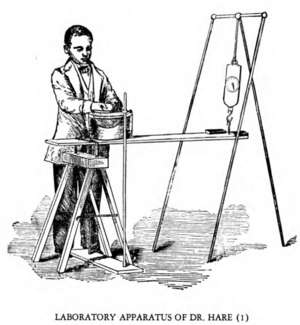Robert Hare (chemist) facts for kids
Robert Hare (born January 17, 1781 – died May 15, 1855) was an important American chemist and a university professor. He was known for inventing new scientific tools and for his later interest in Spiritualism.
Robert Hare's Life and Work
Robert Hare was born in Philadelphia, Pennsylvania, on January 17, 1781. Early in his career, around 1800, he worked with Edward Daniel Clarke to create and test a special tool called the oxy-hydrogen blowpipe. This tool used gases to create a very hot flame.
In 1802, Hare became a member of the American Philosophical Society, a group for important thinkers. He taught at the University of Pennsylvania for many years, first from 1810 to 1812, and then from 1818 to 1847.
By the 1820s, Hare had invented another important device. He called it the "galvanic deflagrator." This was a type of battery with large plates. It was designed to create very fast and strong combustion, which is like a quick burning reaction. In 1824, he was also chosen to be a fellow of the American Academy of Arts and Sciences.
Robert Hare passed away in Philadelphia on May 15, 1858.
Robert Hare and Spiritualism
Later in his life, Robert Hare became interested in Spiritualism. This was a popular belief at the time that people could communicate with spirits of the dead, often through a person called a "medium." In 1853, Hare started doing experiments with mediums.
By 1854, Hare fully believed in Spiritualism. He wrote several books about his findings, which made him very well-known as a Spiritualist in the United States. One of his famous books was called Experimental Investigation of the Spirit Manifestations, published in 1855. While Spiritualists liked his work, many other scientists did not agree with his methods or conclusions.
Hare designed special equipment for his experiments. One setup used a board and a spring scale. Another involved a table where a medium sat. As the table supposedly moved by itself, a pointer would show letters on a wheel. However, some researchers, like Frank Podmore, pointed out that a medium could easily move the table using their knees or other body parts without anyone noticing. Podmore also said that Hare's equipment was clever, but he didn't seem to watch the people involved closely enough to prevent tricks.
Science writer Terence Hines explained why scientists like Hare might have been fooled. He said that even smart scientists can make mistakes when they leave their area of expertise. Being good at science in a lab doesn't mean you're good at spotting magic tricks. Mediums often used tricks that magicians use, like sleight of hand. It takes a magician to spot another magician's tricks, not necessarily a chemist or physicist.
Historian Timothy Kneeland suggested that Hare's interest in Spiritualism fit with his other beliefs about society and government. His book on spirit manifestations also talked about bringing back social order based on ideas of republicanism.



